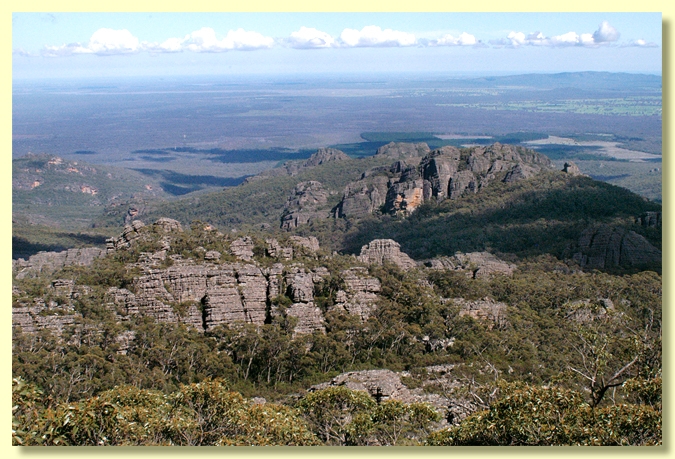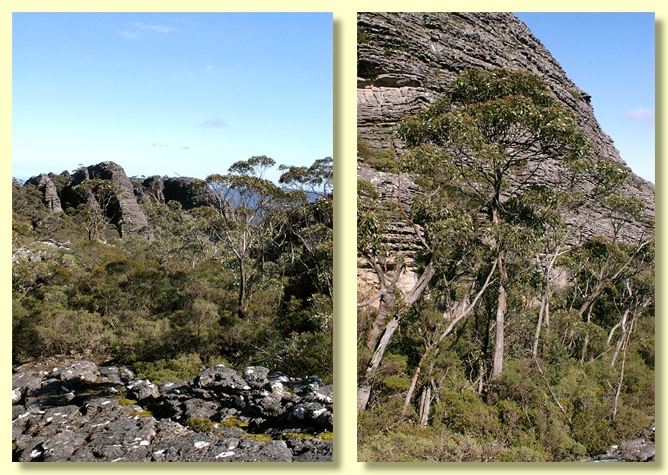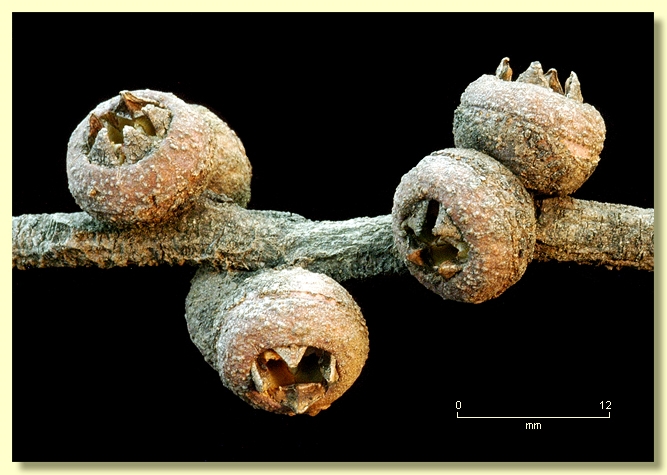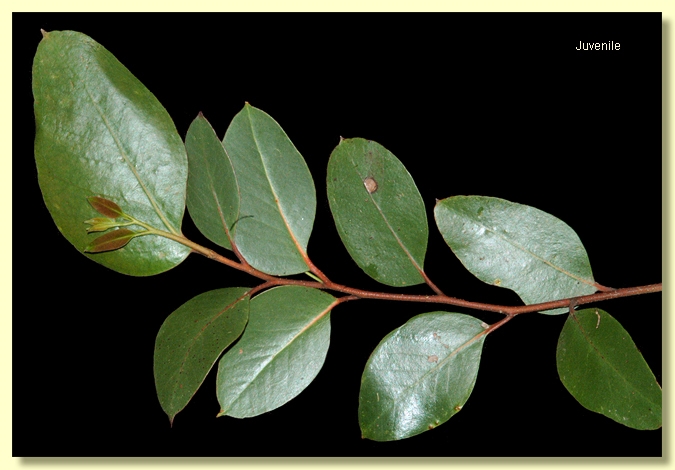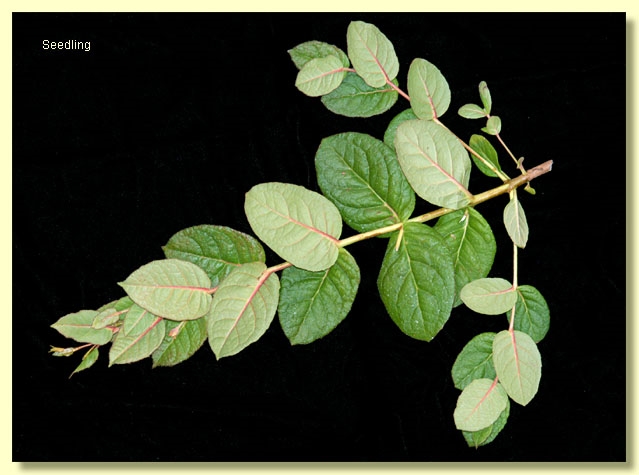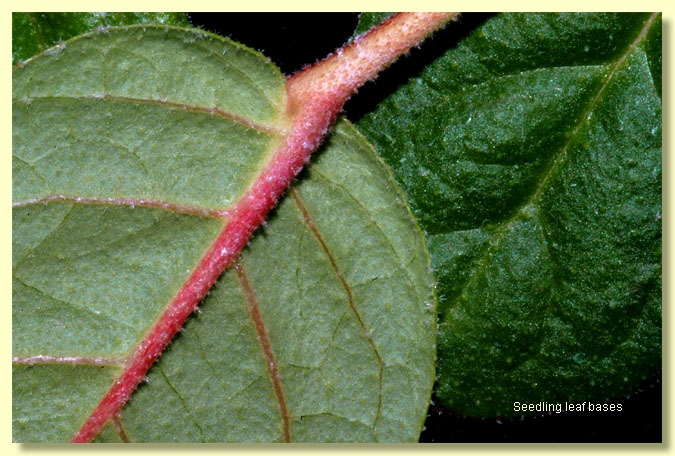Eucalyptus | Eucalyptus | Capillulus | Pachyphloius
Euclid - Online edition
Eucalyptus victoriana
Eucalyptus victoriana Ladiges & Whiffin, Aust. Sys. Bot. 8: 123 (1995).
T: Mount Thackeray, Victoria Range, Grampians, Victoria. Near foot-track to summit, about 1 + km from Victoria range road (37°18'S 142°20'E), 30 April 1987, M.R.Newnham & P.Y.Ladiges 937; holo: MEL.
Tree to 20 m tall but sometimes only to 4 m. Forming a lignotuber.
Bark rough for only part of the trunk, rarely for most of the trunk, with the upper trunk and branches smooth. Rough bark long-fibrous and stringy where best developed lower on trunk, diminishing to fibrous/flaky then smooth pale grey and creamy white..
Juvenile growth (coppice or field seedlings to 50 cm): not seen.
Adult leaves alternate, petiole 0.9–2.4 cm long; blade ovate to elliptical to ovate-elliptic or lanceolate, 7.2–15 cm long, 2–5.5 cm wide, base oblique or tapering to petiole, concolorous, glossy, green, thick, side-veins at an acute or wider angle to midrib, usually sparsely reticulate, intramarginal vein parallel to and well removed from margin, oil glands obscure.
Inflorescence axillary unbranched, peduncles stout, 0–0.5 cm long, buds in umbels of 7, 9 or rarely 11, sessile. Mature buds usually ovoid to oblong, with 3 longitudinal angles, 0.9 cm long, 0.6 cm wide, green, very warty, scar absent, operculum conical to rounded or rarely flattened, stamens irregularly flexed, anthers reniform to cordate, versatile, dorsifixed, dehiscing by confluent slits, style long, stigma tapered, locules 4 or 5 each with 2 vertical ovule rows. Flowers white.
Fruit sessile, the base cup-shaped to hemispherical, 0.5–0.6 cm long, 1–1.4 cm wide, disc raised-annular or raised-convex, valves 4 or 5, at rim level or strongly exserted.
Seeds black or brown, 2–4 mm long, pyramidal or obliquely pyramidal, dorsal surface smooth, hilum terminal.
Cultivated seedlings (measured at ca node 10): cotyledons reniform; stems rounded in cross-section, stellate-hairy until ca node 9 or 10 then smooth; leaves sessile and amplexicaul for ca 3 nodes then shortly petiolate, opposite until node 6 to 13 then becoming alternate, ovate-elliptic, 4.5–7 cm long, 3–5.5 cm wide, base rounded at upper nodes, margin entire, apex rounded and apiculate, stellate-hairy until ca node 9 or 10 then bright glossy green and glabrous.
Flowering time unknown.
A tree with highly restricted distribution on Mount Thackeray and possibly other peaks and upper gullies in the Victoria Range, Grampians area, Victoria. Characteristically Eucalyptus victoriana is a small to moderately tall tree with stringybark over the lower trunk and smooth-barked upper trunk and branches, a glossy green crown of thickish leaves, axillary clusters of 7 to 11 sessile ovoid-oblong buds, which are squat, more or less angular and quite warty.The fruit are tightly clustered and 1-1.4 cm wide with a prominent raised disc. At Mt Thackeray E. victoriana can be readily distinguished from E. baxteri by the thicker crown leaves and smooth-barked branches within the crown.
Eucalyptus victoriana is closely related to and was once included in the widespread Brown Stringybark, E. baxteri (e.g. Brooker & Slee, 1996). The latter species differs in having well-developed stringybark extending to the small branches, much thinner-textured crown leaves and club-shaped buds that are minutely warty. Eucalyptus victoriana differs from its other two close relatives, E. serraensis and E. verrucata , which have more compact fibrous/flaky rough bark or lack rough bark altogether, have crown leaves much thicker and broader, grossly warty sessile buds (in clusters of three or seven in E. serraensis, and in one, three or very rarely seven in E. verrucata), and larger fruit with more locules. Both E. serraensis and E. verrucata are also Grampian endemic species but occur in mountain ranges further east than E. victoriana.
MORE ABOUT STRINGYBARKS
Eucalyptus victoriana : referring to Victoria Range, in the state of Victoria, where it is endemic.

